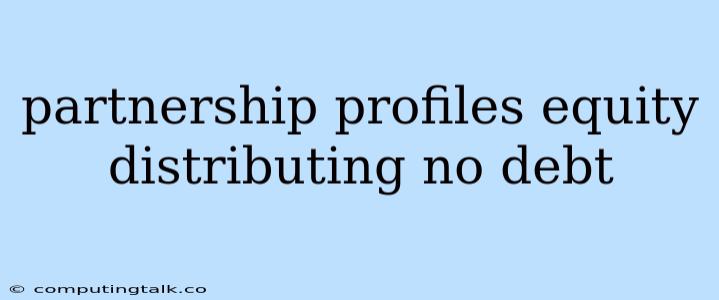Navigating the Partnership Landscape: A Guide to Equity Distribution and Avoiding Debt
Building a successful partnership is a journey that requires careful consideration of various factors, particularly when it comes to equity distribution and managing financial obligations. Partnership profiles can vastly differ, with each partner contributing unique skills, resources, and vision to the venture. However, a clearly defined equity distribution model that fairly reflects these contributions is crucial for a harmonious and thriving partnership.
One of the primary concerns for many partnerships is the question of debt. While debt can sometimes be a necessary tool for accelerating growth, it's essential to approach it strategically.
Understanding Equity Distribution in Partnerships
Equity distribution is the process of dividing ownership shares in a company or venture among its partners. This is a fundamental aspect of any partnership agreement and should be established upfront with meticulous care.
Here's a breakdown of essential considerations for a successful equity distribution:
- Contributions and Value: Carefully assess the unique contributions each partner brings to the table. This can include financial investments, specialized expertise, industry connections, or even intangible assets like creativity and leadership.
- Future Roles and Responsibilities: Outline the anticipated roles and responsibilities of each partner. This will help clarify how each individual's contributions will translate into tangible benefits for the partnership.
- Exit Strategy: Consider how equity will be handled if a partner decides to leave the venture or if the partnership dissolves. This includes clear procedures for buyouts and share transfers.
Tip: A transparent and well-documented equity distribution plan minimizes potential conflict and fosters a sense of fairness among partners.
The Role of "No Debt" in Partnership Strategies
No debt partnerships aim to achieve growth and success without incurring external financial obligations. This approach can be particularly advantageous for startups or early-stage ventures.
Here are the potential benefits of a "no debt" strategy:
- Financial Independence: Avoiding debt grants greater autonomy and flexibility in decision-making.
- Reduced Risk: Eliminating debt obligations lowers the financial risk for partners, as they don't face pressure from loan repayments.
- Focus on Organic Growth: A "no debt" approach encourages partners to focus on building sustainable, organic growth through their combined efforts.
However, a "no debt" strategy also has potential limitations:
- Slower Growth: Without external funding, growth may be slower compared to ventures that leverage debt.
- Limited Investment Opportunities: A "no debt" approach can limit the ability to invest in opportunities that require significant capital upfront.
Balancing Equity Distribution and "No Debt"
The key lies in striking a balance between equity distribution and a "no debt" approach. Here are some strategies to achieve this balance:
- Creative Funding Solutions: Explore alternative funding sources that don't involve traditional debt, such as crowdfunding, angel investors, or bootstrapping.
- Strategic Partnerships: Seek partnerships with companies or individuals who can provide resources or expertise in exchange for equity or other mutually beneficial arrangements.
- Profit Sharing Agreements: Implement a profit-sharing model that incentivizes partners to focus on maximizing profitability.
Example: A technology startup could leverage a "no debt" strategy by collaborating with a larger, established company that offers resources in exchange for a percentage of equity.
Building a Sustainable Partnership
Ultimately, a sustainable partnership is built on strong foundations of trust, open communication, and a shared vision. Equity distribution, while a crucial aspect of the partnership structure, is just one piece of the puzzle.
Here are key elements for building a strong and enduring partnership:
- Clear Communication: Establish a culture of open and transparent communication, where partners can share concerns and work collaboratively on solutions.
- Shared Vision: Define a clear and compelling vision for the partnership that motivates and inspires all partners to work towards a common goal.
- Flexible Adaptation: Recognize that the partnership landscape is constantly evolving, and be prepared to adapt and adjust strategies as needed.
Conclusion
Partnership profiles, equity distribution, and the "no debt" approach are interconnected elements that must be carefully considered when embarking on a collaborative venture. By prioritizing transparency, fairness, and a long-term vision, partners can create a foundation for a successful and enduring partnership that thrives on mutual growth and shared success.
